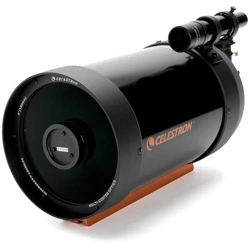Loading ...
Loading ...

SCT & EDGEHD COLLIMATION GUIDE | 3
COLLIMATION SETUP
As you did when checking collimation, make sure your system
is acclimatized to the outside temperature before you begin the
collimation process.
To collimate your SCT or EdgeHD, you will need a pinpoint light
source. A bright star works great. A bright star near the zenith is
ideal since there is minimal atmospheric distortion in that part of
the sky. Make sure that your mount’s tracking is turned on, so the
star won’t drift as you are making collimation adjustments. Or, if
you are using a roughly polar aligned equatorial mount and you
do not want to power up your telescope, you can choose Polaris
as your collimation star. Its position relative to the celestial pole
means that it moves very little, eliminating the need to track it.
If seeing conditions (i.e. air steadiness) are turbulent, collimation
will be diffi cult to judge (see Figure 4). This is because the
extra-focal diffraction patterns that need to be evaluated will be
smeared and blurred. Wait until a better night if it is turbulent or
aim to a steadier part of the sky. Look for a part of the sky with
steady—not twinkling—stars. If stars are twinkling, then conditions
are poor, and it may be hard to achieve proper collimation. If
seeing conditions are good (see Figure 5), you can use a high-
powered eyepiece (i.e. focal length less than 10mm) to achieve
the most precise optical alignment. If seeing conditions are ideal,
use an eyepiece with even more magnifi cation (i.e. focal length
between 2.3mm and 7mm) for the best results.
Next, if you have one attached, remove the dew shield from your
telescope. This will provide best access to the collimation screws.
NOTE: If you are outside in heavy dew conditions when attempting
to collimate, you may need to consider using an optional
dew heater system; this will prevent dew from forming on
the Schmidt corrector while you adjust collimation.
When connecting the eyepiece to the telescope, make sure
all thumbscrews are fi rmly tightened, as this helps ensure the
eyepiece is best mechanically aligned with the optical axis. Also,
make sure the retaining ring that connects the visual back to
the rear cell of the telescope is securely tightened. If you will
be subsequently using the telescope for imaging with a camera,
consider collimating the telescope with the eyepiece inserted
directly into the visual back, without a diagonal in place. Doing so
will remove any source of alignment error which may arise from
the diagonal itself.
After making each collimation adjustment, you will need to
re-center the bright star in the eyepiece. If using a computerized
mount, you should use your telescope’s hand control to move
the telescope (use a slow speed rate) and re-center the star. So,
make sure the hand control is in a handy location nearby.
Fig. 4 Out of focus star under turbulent
conditions
Fig. 5 Out of focus star under good seeing
conditions
Loading ...
Loading ...
Loading ...
